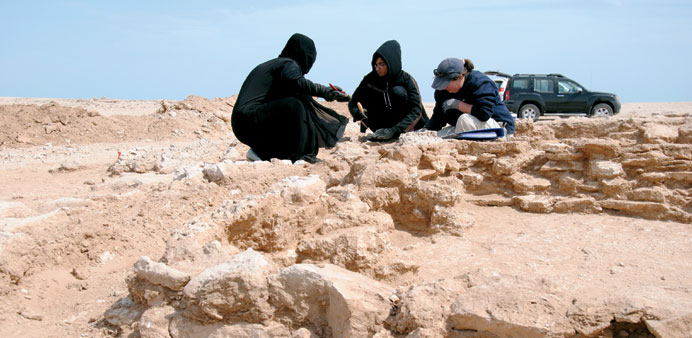Archaeologists from Qatar Museums Authority and University of Birmingham seen amid the remains of the seventh century Islamic dwelling, to the south of Al Wakrah.
By Bonnie James/Deputy News Editor
A team of archaeologists from the Qatar Museums Authority (QMA) and the University of Birmingham have discovered the remains of a seventh century Islamic dwelling, to the south of Al Wakrah.
They are working for the Qatar National Historic Environment Project (QNHER), developed as a joint initiative between the QMA, under the guidance of Faisal al-Naimi (head of Antiquities) and Richard Cuttler, a research fellow of the University of Birmingham.
Though the site was stumbled upon more than a year and a half ago during an archaeological survey ahead of the development of the New Doha Port, its importance was not immediately clear as very little archaeological evidence was visible on the surface.
“Sites of this period are extremely rare, not just in Qatar but in the Gulf region” al-Naimi told Gulf Times.
“We are working closely with developers across Qatar in order to ensure that historical sites which may be affected by new developments can be recorded or protected. The discovery of sites like this, as part of large infrastructure projects, reinforces the need to preserve and document Qatar’s important cultural heritage,” he explained.
Site director Kate Bain said the team had already investigated many prehistoric burial cairns, several lithic scatters and a temporary mosque.
“This was the last of the sites in the area of the development and when we began excavation, it looked like a prehistoric cairn” she said, while observing that the last thing the archaeologists really expected was a very early Islamic building.
Nestled between natural stone ridges about 1km from the modern coastline, the building has remained hidden for more than a thousand years beneath thick deposits of windblown sand and the rubble of its final collapse.
The house once had three large rooms, one of which was divided into a smaller, private room. The walls survived to more than half a metre high and had been built from flat slabs of beach rock and mud-mortar.
“When the walls collapsed they literally fell to the outside, but remained complete, so the upper portions of the walls could be seen, lying on their sides as vertical stones’ explained Bain.
“As we were carrying out the delicate process of excavating layers of sand and rubble overlying the floors, we revealed several hearths with fragments of pottery, fish bones and shellfish” said QMA team member, Fatima Merekhan. She was joined on the excavation by her sister, as part of her school’s work experience programme.
“This evidence helps us to understand what the people who lived here were eating and how they were preparing food. All of the excavated material was sieved, in order to recover even the smallest of artefacts, which included tiny fish bones and small marine molluscs” explained Merekhan.
Radiocarbon dates suggest the house was built sometime between 600 and 630AD. The team have been working with specialists from the University College London Qatar to analyse the pottery assemblage, which suggests the house was in use for around 100 years.
One of the most interesting aspects is that the building is entirely on its own, with no other structures or features of this period. “While this may be due to preservation from the natural topography it seems likely that if there were other structures we would have found some evidence for them. So this remains a mystery” said Bain. “We hope to unravel this further by analysing the environmental remains, artefacts and data from the site” she added.
Given the exceptional preservation of the dateable, stratified, layers within the structure, the team also expect that the pottery will form part of an important assemblage for establishing more secure regional pottery chronologies for the 7th and 8th centuries AD.
“The range of sites, excavated in advance of the Doha New Port project, has given us unique glimpse of the rich archaeological heritage of the area” commented Merekhan.
“It is fantastic to have the opportunity to excavate such an important site and to contribute to the growing understanding of our country’s heritage” she concluded.

